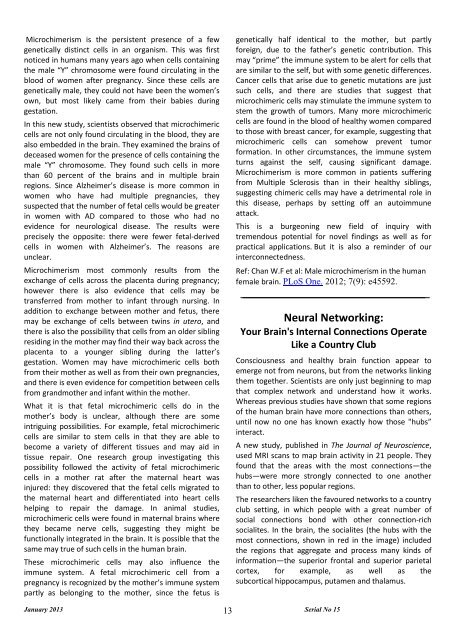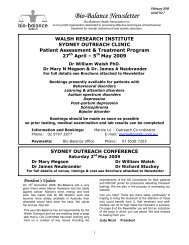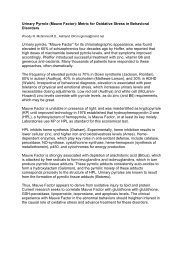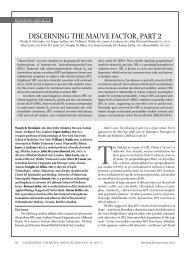Download PDF - Bio-Balance Health
Download PDF - Bio-Balance Health
Download PDF - Bio-Balance Health
- No tags were found...
You also want an ePaper? Increase the reach of your titles
YUMPU automatically turns print PDFs into web optimized ePapers that Google loves.
Microchimerism is the persistent presence of a fewgenetically distinct cells in an organism. This was firstnoticed in humans many years ago when cells containingthe male “Y” chromosome were found circulating in theblood of women after pregnancy. Since these cells aregenetically male, they could not have been the women’sown, but most likely came from their babies duringgestation.In this new study, scientists observed that microchimericcells are not only found circulating in the blood, they arealso embedded in the brain. They examined the brains ofdeceased women for the presence of cells containing themale “Y” chromosome. They found such cells in morethan 60 percent of the brains and in multiple brainregions. Since Alzheimer’s disease is more common inwomen who have had multiple pregnancies, theysuspected that the number of fetal cells would be greaterin women with AD compared to those who had noevidence for neurological disease. The results wereprecisely the opposite: there were fewer fetal-derivedcells in women with Alzheimer’s. The reasons areunclear.Microchimerism most commonly results from theexchange of cells across the placenta during pregnancy;however there is also evidence that cells may betransferred from mother to infant through nursing. Inaddition to exchange between mother and fetus, theremay be exchange of cells between twins in utero, andthere is also the possibility that cells from an older siblingresiding in the mother may find their way back across theplacenta to a younger sibling during the latter’sgestation. Women may have microchimeric cells bothfrom their mother as well as from their own pregnancies,and there is even evidence for competition between cellsfrom grandmother and infant within the mother.What it is that fetal microchimeric cells do in themother’s body is unclear, although there are someintriguing possibilities. For example, fetal microchimericcells are similar to stem cells in that they are able tobecome a variety of different tissues and may aid intissue repair. One research group investigating thispossibility followed the activity of fetal microchimericcells in a mother rat after the maternal heart wasinjured: they discovered that the fetal cells migrated tothe maternal heart and differentiated into heart cellshelping to repair the damage. In animal studies,microchimeric cells were found in maternal brains wherethey became nerve cells, suggesting they might befunctionally integrated in the brain. It is possible that thesame may true of such cells in the human brain.These microchimeric cells may also influence theimmune system. A fetal microchimeric cell from apregnancy is recognized by the mother’s immune systempartly as belonging to the mother, since the fetus isgenetically half identical to the mother, but partlyforeign, due to the father’s genetic contribution. Thismay “prime” the immune system to be alert for cells thatare similar to the self, but with some genetic differences.Cancer cells that arise due to genetic mutations are justsuch cells, and there are studies that suggest thatmicrochimeric cells may stimulate the immune system tostem the growth of tumors. Many more microchimericcells are found in the blood of healthy women comparedto those with breast cancer, for example, suggesting thatmicrochimeric cells can somehow prevent tumorformation. In other circumstances, the immune systemturns against the self, causing significant damage.Microchimerism is more common in patients sufferingfrom Multiple Sclerosis than in their healthy siblings,suggesting chimeric cells may have a detrimental role inthis disease, perhaps by setting off an autoimmuneattack.This is a burgeoning new field of inquiry withtremendous potential for novel findings as well as forpractical applications. But it is also a reminder of ourinterconnectedness.Ref: Chan W.F et al: Male microchimerism in the humanfemale brain. PLoS One. 2012; 7(9): e45592.Neural Networking:Your Brain's Internal Connections OperateLike a Country ClubConsciousness and healthy brain function appear toemerge not from neurons, but from the networks linkingthem together. Scientists are only just beginning to mapthat complex network and understand how it works.Whereas previous studies have shown that some regionsof the human brain have more connections than others,until now no one has known exactly how those "hubs”interact.A new study, published in The Journal of Neuroscience,used MRI scans to map brain activity in 21 people. Theyfound that the areas with the most connections—thehubs—were more strongly connected to one anotherthan to other, less popular regions.The researchers liken the favoured networks to a countryclub setting, in which people with a great number ofsocial connections bond with other connection-richsocialites. In the brain, the socialites (the hubs with themost connections, shown in red in the image) includedthe regions that aggregate and process many kinds ofinformation—the superior frontal and superior parietalcortex, for example, as well as thesubcortical hippocampus, putamen and thalamus.January 2013 13Serial No 15













